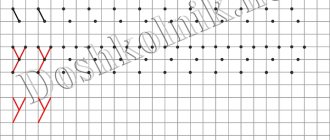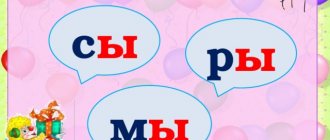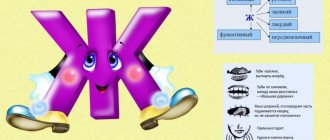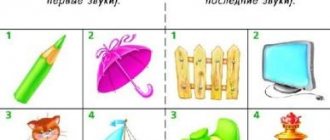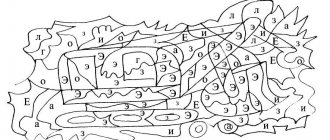Self-analysis of a speech development lesson in grade 1a
Self-analysis of a speech development lesson in grade 1a
Teacher:
I gave a lesson in speech development in grade 1a according to the program “Special (correctional) educational institutions of type II” (2nd department, option II)
Lesson type – combined.
Solving the educational tasks of the lesson meets the requirements of the speech development program for 1st (hard of hearing) grade.
Tasks:
Educational:
- expand knowledge about the family; develop the ability to compose sentences using reference words; development of students' oral and written speech by enriching students' vocabulary; develop the ability to test your knowledge and objectively evaluate the results of your work; practice and improve the studied material.
- practice and improve the studied material.
Educational:
- correct visual perception based on exercises in recognition and discrimination; develop verbal memory based on exercises in memorization and reproduction; the ability to improve mental actions: analysis, comparison, generalization; work on the development of students' residual hearing.
Educational:
- increase interest in the subject; creating conditions for active cognitive activity of students; cultivate discipline, composure, independence, perseverance.
Teaching methods: reproductive, problem-based, programmed.
Forms of organization of cognitive activity: frontal,
individual, group.
Learning tools: Mimio Studio presentation, didactic material.
In accordance with the type of lesson, the following lesson structure was provided:
1. Organizational stage.
Purpose: preparing students for work in the classroom.
2. Preparing students to perceive the topic.
Purpose: to organize the cognitive activity of students, to communicate the topic,
objectives of the lesson, to attract attention and arouse interest in
studying this topic.
3.Main stage of the lesson
Goal: to continue working on the content of the material being studied.
- Game for attention Game "Settled in the house." Making sentences based on pictures.
4. Summing up the lesson. Reflection of activity.
Purpose: to draw a conclusion and summarize.
During the lesson, methods were used based on the type of information source:
- verbal (dialogue in preparation for active cognitive activity, at the stage of updating knowledge, conversation based on a picture) visual (throughout the entire lesson, the work was accompanied by a presentation) practical (students completed tasks on the card)
By type of educational activity:
used the problem method (students underlined the words from which they chose the ones they needed). I used pair work for collaboration that helps develop a person's self-confidence. It helps children quickly find their way around.
Forms of cognitive activity: general class.
Visual, technical, and didactic teaching aids are used in the lesson. All these methods, forms and means helped to achieve the goals set in the lesson.
During the lesson I used the following forms of work: frontal, independent, individual.
Complied with the principle of accessibility of the proposed educational information. All tasks turned out to be feasible for the students.
Didactic side of the lesson
- The material is easy to understand. The stages of the lesson are interconnected and sequential. Students understood the questions and found answers to them. A visual method was used.
The content of the educational material and the types of work used in the lesson were aimed at maintaining the cognitive activity of students throughout the lesson.
Requirements for a modern lesson include the use of information technology. Therefore, a computer presentation was created.
Taking into account the psychological and age characteristics of students of this age, the main stage of the lesson included health - saving technologies: physical education.
From an educational point of view, the lesson contributed to the development in children of respect and love for their loved ones.
The lesson has achieved its objectives.
The structure of the lesson fully complies with the logic of the stated type of lesson, since my organizational task was to create conditions for further perception and consolidation of material on this topic. In my opinion, such conditions were created during the lesson.
When organizing and conducting the lesson, I tried to create a situation of psychological comfort for the children, when each student is successful in his opinion, he is not afraid to speak out.
The use of an element of dialogue leads students to social adaptation and increases their level of sociability. That is, the method of creative well-being and the method of creative self-expression, used in the lesson, allow you to develop the skills of voluntary behavior, a sense of a partner, imagination, and observation. These methods lead to the effective emancipation of one’s own individuality, the manifestation of creative activity and independence.
The students in the lesson were active, attentive, and efficient. I believe that the chosen form of organizing the educational activities of schoolchildren was quite effective. On my part, the norms of pedagogical ethics and tact, and the culture of “teacher-student” communication were observed.
Throughout the lesson, I monitored the children’s speech, corrected mistakes in the pronunciation of endings, and paid attention to accents.
The results of the lesson indicate that during the lesson the students repeated previously acquired knowledge and drew conclusions for themselves. At the final stage of the lesson, the children assessed their work; self-esteem is one of the conditions for the development of a full-fledged personality. Students were given differentiated homework.
Get text
Self-analysis of an integrated lesson on speech development in the middle group
Yulia Prikhodko
Self-analysis of an integrated lesson on speech development in the middle group
Self-analysis of an integrated lesson on speech development
on topic: “Wild animals in autumn”
in the middle group (children age 4-5 years)
Prikhodko Yulia
A subgroup of 8 children of middle preschool age in this Children in this group have developed cognitive skills, they know how to hear and listen to the teacher, and they easily make contact.
GCD theme: “Wild animals in autumn”
.
The main direction is speech development . This GCD was planned in accordance with the requirements of the Federal State Educational Standard and SanPiN. GCD includes the integration of the following educational areas - cognition, socialization, communication, fiction, physical education, music. When developing this outline of the GCD, first of all, I took into account the age and individual characteristics of the development of children , and based on this, I outlined the goal, objectives, content of the activity, determined the form of implementation, methods, techniques and means necessary to achieve positive results.
Goal: To develop preschoolers’ interest in natural objects . Expanding your horizons and ideas about changes in the lives of animals in the fall.
Tasks:
Educational
• Develop a caring attitude towards living nature.
• Develop personality qualities : empathy, responsiveness.
Educational
• Continue to become familiar with the characteristic features of the appearance of wild animals.
• Expand your understanding of wild animals (a bear, a hedgehog are preparing for hibernation, a squirrel is stocking up for the winter, hiding it in its “pantries”
, foxes, hares, squirrels molt, features of the wolf).
Developmental
• Promote the development of cognitive interest in children .
• Encourage children to answer in complete, common sentences.
• Develop auditory attention , verbal and logical thinking.
Equipment: Christmas trees, mushrooms (models, pictures of wild animals (wolf, fox, squirrel, hare, hedgehog, basket.
Handout: a set of pictures depicting animals.
The GCD consisted of three interconnected stages, during which children performed various actions. This structure is completely justified, since each stage is aimed at solving certain problems.
The first, organizational stage, involved organizing children and creating motivation for further activities. These tasks were realized through such techniques as play - reading a poem and a surprise moment - a trip to the forest.
The main part was a specially organized joint activity with the teacher and independent activities of children aimed at solving the assigned tasks of the GCD. The implementation of the tasks was ensured by the use of the following methods and techniques during the main stage of the GCD:
- verbal method, through such techniques as introductory and informative conversation, explanation, instructions, asking questions, repeated pronunciation, reading a literary work, verbal encouragement.
- a visual method, through observing the teacher demonstrate actions, demonstrating objects, a sample, demonstrating a method of performing actions, demonstrating computer illustrations.
- a practical method through imitative, constructive and creative exercises, modeling.
- game method - creating a game situation.
The goal of the final stage of this GCD was to sum up the results of all activities and conduct reflection in a playful way using a ball.
In my opinion, the methods and techniques I chose when planning the content and conducting this GCD were the most effective in achieving the goals. A constant change of activities made it possible to eliminate the occurrence of overwork in children. interactive in ECD expanded cognitive capabilities and ensured the interest of children throughout the ECD. The children were in a positive mood, showed both cognitive and physical activity, and were happy to engage in the activities I suggested.
I believe that I conducted this GCD in an emotionally positive environment. The chosen form of NOD organization was quite effective, logical and dynamic. The goal and objectives of the activity have been achieved.

